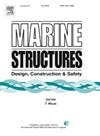通过实验分析和双向 CFD-FEA 耦合方法研究船舶在规则波浪中的高阶弹簧作用
IF 5.1
2区 工程技术
Q1 ENGINEERING, CIVIL
引用次数: 0
摘要
本文通过实验和数值测量研究了分段驳船模型的高阶弹跳现象。在计算流体动力学(CFD)和有限元分析(FEA)之间开发了一种高效的内部双向耦合数值求解器,并根据实验结果进行了验证。耦合方法基于域分离法,需要在不同的域中解决单独的边界值问题。为确保这些单独域内的收敛性,采用了隐式数值方案,并进一步促进了耦合变量的交换。目前的方法强调两个求解器之间的整体收敛性,保持强耦合设置,以全面解决流固耦合现象,包括附加质量和阻尼效应。首先进行了一系列水箱试验,以测量波浪引起的断面载荷和运动,期间观察了波浪载荷的高阶谐波的弹跳响应。通过将刚体运动和柔性垂直弯矩(VBM)的数值预测与水箱试验结果进行比较,发现所提出的数值方法与试验结果一致,从而肯定了其有效性和稳健性。最后,讨论并研究了高达 14 次谐波的弹簧响应。本文章由计算机程序翻译,如有差异,请以英文原文为准。
Investigation of higher-order springing of a ship in regular waves by experimental analysis and two-way CFD-FEA coupled method
In this paper, the higher-order springing phenomenon is addressed for a segmented barge ship model through experimental and numerical measures. An efficient in-house two-way coupled numerical solver between Computational Fluid Dynamics (CFD) and Finite Element Analysis (FEA) is developed and validated against experimental results. The coupling method is based on a domain-separated approach and necessitates the resolution of individual boundary value problems in distinct domains. To ensure convergence within these individual domains, an implicit numerical scheme is employed and further facilitated exchange of variables for coupling. The current approach emphasizes the overall convergence between two solvers, maintaining a strongly coupled setup to comprehensively address fluid-structure interaction phenomena, including added mass and damping effects. A series of tank tests were conducted first to measure the wave-induced sectional loads and motions, during which the springing responses to very high-order harmonics of wave load were observed. By comparing the numerical prediction with the tank test results for rigid body motion and flexible vertical bending moment (VBM), the proposed numerical method demonstrated agreement with experimental results, affirming its validity and robustness. Finally, the springing response up to 14th order harmonics is discussed and investigated.
求助全文
通过发布文献求助,成功后即可免费获取论文全文。
去求助
来源期刊

Marine Structures
工程技术-工程:海洋
CiteScore
8.70
自引率
7.70%
发文量
157
审稿时长
6.4 months
期刊介绍:
This journal aims to provide a medium for presentation and discussion of the latest developments in research, design, fabrication and in-service experience relating to marine structures, i.e., all structures of steel, concrete, light alloy or composite construction having an interface with the sea, including ships, fixed and mobile offshore platforms, submarine and submersibles, pipelines, subsea systems for shallow and deep ocean operations and coastal structures such as piers.
 求助内容:
求助内容: 应助结果提醒方式:
应助结果提醒方式:


